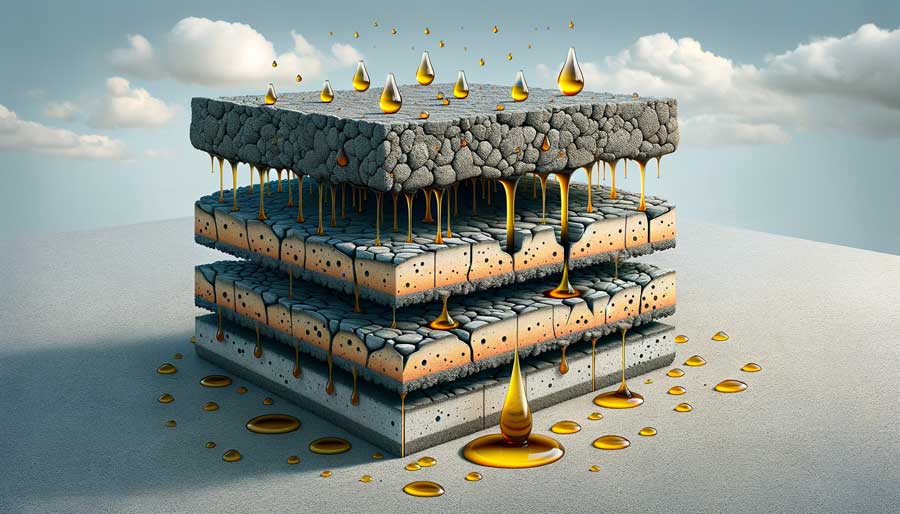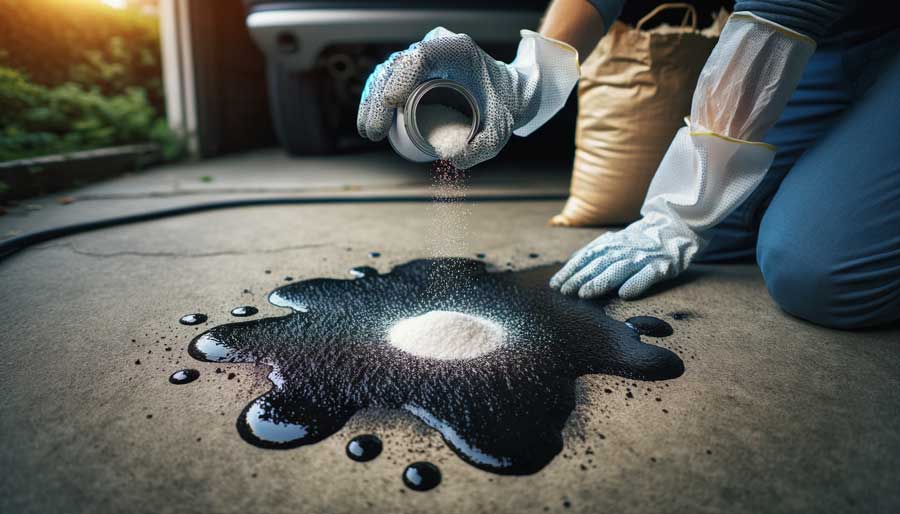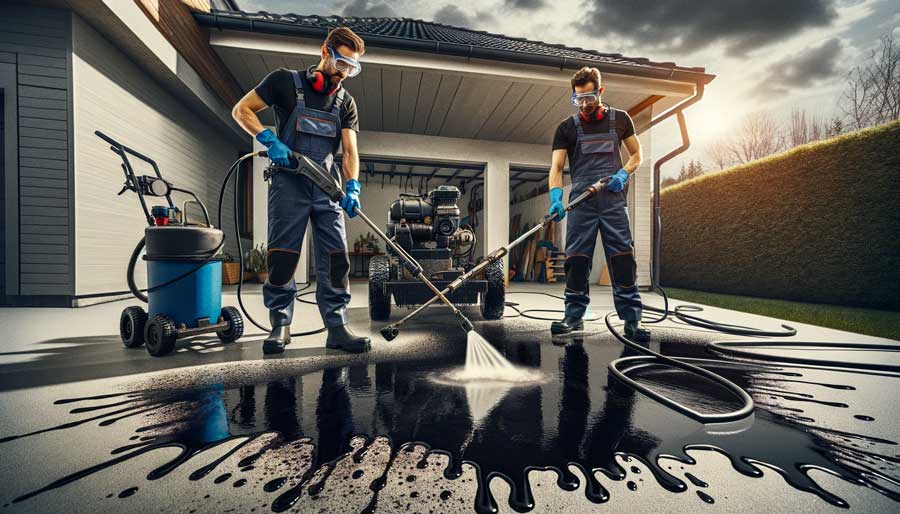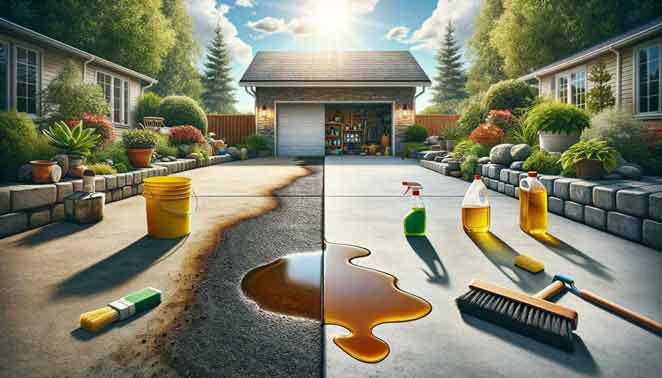Oil stains on concrete are a common yet challenging problem faced by many. Whether it’s a driveway marred by motor oil or a garage floor splattered with grease, figuring out how to get oil out of concrete can be daunting. The porous nature of concrete means that oil can quickly seep deep into the surface, creating stubborn stains that resist ordinary cleaning methods.
Thankfully, with the right approach and some persistence, these unsightly blemishes can be removed. This article aims to guide you through effective methods for tackling oil stains on concrete surfaces. From DIY solutions to advanced cleaning techniques, we’ll cover a range of strategies to restore your concrete’s appearance.
Understanding the interaction between concrete and oil, and the types of stains you might encounter, is the first step toward a clean and oil-free surface. Let’s dive into the solutions that can make this cleaning task less of a headache and more of a manageable project.
Understanding the Complexity of Oil Stains on Concrete
The Nature of Concrete and Oil Interaction
Concrete isn’t just hard; it’s like a sponge when it comes to oil. This porosity means oil doesn’t just sit on the surface—it dives deep into the concrete’s pores. This deep penetration is what makes removing oil from concrete a real challenge. Each stain can be a complex puzzle, with the oil entangling itself within the labyrinth of concrete’s microscopic cavities.
Types of Oil Stains
Not all oil stains are created equal. From the thick, dark spots left by motor oil to the lighter stains of cooking oil, each type brings its own set of challenges. Motor oil, often found on driveways, is notoriously stubborn. Cooking oil, while seeming less menacing, can still seep deeply into patio or kitchen outdoor concrete surfaces. Recognizing the type of oil you’re dealing with is crucial in selecting the right removal method.

Navigating the removal of oil stains from concrete requires an understanding of both the material’s nature and the characteristics of the stain itself. Armed with this knowledge, you can better approach the task at hand, employing strategies that target the stain effectively. Whether it’s a fresh spill or an old, set-in stain, the battle against oil on concrete is winnable with patience and the right techniques.
Pre-Treatment Steps for Oil Stain Removal
Assessing the Stain
Before you dive into the cleaning process, take a moment to assess the oil stain. The age, size, and depth of the stain can significantly impact your approach. Fresh stains are generally easier to tackle, while older stains may require more robust methods. Understanding the stain’s history helps in choosing the most effective treatment, saving time and effort in the long run.
Initial Cleaning
The first step in addressing an oil stain on concrete is to remove any excess oil. Absorbent materials like cat litter, baking soda, or cornstarch are excellent for soaking up fresh oil. Simply sprinkle the absorbent over the stain and let it sit for a few hours or overnight. Then, sweep or vacuum it up. This initial cleanup is crucial for preventing the oil from penetrating deeper into the concrete.

The pre-treatment phase is all about preparation, setting the stage for the more intensive cleaning methods that follow. By assessing the stain and performing an initial cleanup, you’re laying the groundwork for a more successful oil removal process. Next, we’ll explore a variety of methods to get that stubborn oil out of your concrete, from simple household remedies to professional-grade solutions.
DIY Methods: How to Get Oil Out of Concrete
Dish Soap and Hot Water Technique
One of the simplest yet effective methods to tackle oil stains on concrete involves items you likely already have at home: dish soap and hot water. Dish soap is designed to cut through grease, making it perfect for oil stain removal. First, apply a generous amount of dish soap to the stain and let it sit for a few minutes to break down the oil. Then, scrub the area with a stiff brush and rinse it off with hot water. This method is particularly effective for fresh stains or those that haven’t penetrated deeply into the concrete.
Using a Degreaser
For more stubborn or older stains, a commercial degreaser can be a game-changer. These products are specifically formulated to dissolve oil and grease. When selecting a degreaser, look for one that’s environmentally friendly and suitable for use on concrete. Apply the degreaser according to the manufacturer’s instructions, usually by spreading it over the stain, allowing it to sit, and then scrubbing with a stiff brush. Rinse thoroughly with water afterward. Always wear gloves and protective eyewear when handling chemical degreasers to ensure your safety.

DIY methods offer a cost-effective and accessible way to address oil stains on concrete. Whether employing everyday household items like dish soap or utilizing specialized cleaning products like degreasers, these techniques can make a significant impact. Remember, the key to success lies in prompt action and choosing the right method based on the stain’s severity. With a little effort and the right approach, you can restore your concrete surfaces to their former glory.
Advanced Cleaning Techniques
Pressure Washing
For oil stains that resist initial treatment efforts, pressure washing presents a powerful solution. This method uses high-pressure water to blast oil out of concrete pores, effectively removing deep-seated stains. Before you start, make sure the pressure washer is set to a suitable pressure level to avoid damaging the concrete. It’s often beneficial to combine pressure washing with a degreasing agent for even better results. Apply the degreaser first, let it sit according to the instructions, and then use the pressure washer to rinse the area thoroughly. While pressure washing can be highly effective, it’s important to proceed with caution and consider professional assistance for the best outcome without risking damage to your concrete.
Poultice Method
The poultice method is a more intensive approach for tackling the most stubborn of oil stains. It involves creating a paste-like mixture, typically using an absorbent material like clay and a strong solvent. This mixture is applied thickly over the stain, covered with plastic to slow evaporation, and left to sit for several days. As the poultice dries, it draws the oil out of the concrete and into the absorbent material. Once fully dry, the poultice can be scraped off, taking much of the stain with it. This method requires patience and may need to be repeated for complete stain removal, but it can be incredibly effective for those challenging stains that other methods fail to address.
Advanced cleaning techniques like pressure washing and the poultice method offer robust solutions for oil stains that linger despite initial treatment efforts. These methods delve deeper into the concrete’s pores, tackling stains that surface-level treatments can’t reach. While they may require more time, equipment, or materials, the results can be well worth the effort, restoring your concrete to a clean, oil-free state. Remember, when dealing with tough stains, persistence and the right approach are your best allies.
Professional Solutions and When to Call in the Experts
Hiring a Professional Cleaning Service
Sometimes, despite your best efforts, an oil stain on concrete refuses to budge. In such cases, it might be time to consider hiring a professional cleaning service. These experts have access to industrial-grade equipment and advanced cleaning solutions not typically available to the general public. A professional can assess the stain, determine the most effective treatment, and execute the cleaning process efficiently, saving you time and frustration. Additionally, they can offer advice on preventing future stains and maintaining your concrete surfaces.
Evaluating the Need for Professional Help
Determining when to call in the experts depends on several factors. Consider the size, severity, and age of the stain, as well as the methods you’ve already tried. If the stain covers a large area or is located in a critical or highly visible part of your property, professional cleaning might be the best option. Similarly, if you’ve attempted multiple DIY methods without success, a professional’s expertise could be the key to removing the stain.

Professional solutions offer a reliable alternative when DIY methods fall short. With their specialized knowledge and equipment, professionals can tackle the toughest stains, providing a level of cleanliness and restoration that might be difficult to achieve on your own. While calling in the experts represents an additional expense, the investment can be worthwhile for ensuring your concrete surfaces are clean, well-maintained, and aesthetically pleasing.
Conclusion: Restoring Your Concrete’s Cleanliness
Oil stains on concrete can be a nuisance, but with the right approach, they don’t have to be permanent. From simple household remedies to advanced cleaning techniques and the option of professional services, there are multiple paths to achieving a stain-free surface. The key is to assess the situation carefully, choose the most appropriate method, and act promptly. Whether you tackle the stain yourself or enlist the help of professionals, restoring your concrete’s cleanliness is within reach. Remember, patience and perseverance are your best tools in the fight against oil stains on concrete.









